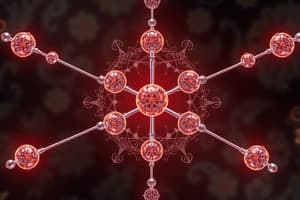Podcast
Questions and Answers
What is electronegativity a measure of?
What is electronegativity a measure of?
- The attraction of an atom for electrons in a bond (correct)
- The number of electrons in an atom
- The size of an atom
- The ability of an atom to form an ionic bond
In a polar covalent bond, electrons are pulled towards which type of element?
In a polar covalent bond, electrons are pulled towards which type of element?
- The element with greater electronegativity (correct)
- Neither of the elements
- Both elements equally
- The element with lesser electronegativity
When do atoms form a nonpolar bond?
When do atoms form a nonpolar bond?
- When the electrons are shared unequally between the two atoms
- When both atoms have different electronegativities
- When the electronegativities of the two atoms are equal or similar (correct)
- When the bond is ionic
What is indicated by the symbol δ+ in a bond?
What is indicated by the symbol δ+ in a bond?
How is the polarity of a molecule determined?
How is the polarity of a molecule determined?
What is a common characteristic of nonpolar molecules?
What is a common characteristic of nonpolar molecules?
What is the number of electrons in a triple bond?
What is the number of electrons in a triple bond?
Which element needs only two electrons in bonding?
Which element needs only two electrons in bonding?
What is the purpose of resonance structures?
What is the purpose of resonance structures?
What is the term for the theory used to determine the shape around a given atom?
What is the term for the theory used to determine the shape around a given atom?
What happens when drawing Lewis structures for polyatomic ions?
What happens when drawing Lewis structures for polyatomic ions?
Which elements have empty d orbitals available to accept electrons?
Which elements have empty d orbitals available to accept electrons?
What happens when two nonmetals combine or a metalloid bonds to a nonmetal?
What happens when two nonmetals combine or a metalloid bonds to a nonmetal?
What is a molecule?
What is a molecule?
What is the main purpose of drawing a Lewis structure?
What is the main purpose of drawing a Lewis structure?
What happens when a lone pair of electrons is converted into a bonding pair?
What happens when a lone pair of electrons is converted into a bonding pair?
What is the number of electrons that hydrogen shares?
What is the number of electrons that hydrogen shares?
What is the goal of atoms in forming covalent bonds?
What is the goal of atoms in forming covalent bonds?
Flashcards are hidden until you start studying




